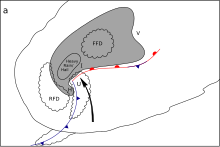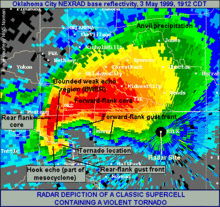Hook echo

As hook echo (engl .: Hook echo ) a special hook-like pattern on the screen of a precipitation radar , respectively. A hook-shaped extension appears on the radar image (“echo”) of the precipitation ( rain and often also hail ) of a thunderstorm . This hook is usually in the right, rear part of the thunderstorm (viewed in the direction of movement). The hook echo is an essential indicator for the existence of a rotating updraft area, the mesocyclones . Its appearance suggests that the thunderstorm is a super cell with a high tornado risk . It is created by precipitation, which is wrapped around the low-precipitation mesocyclones due to the rotation. The "hit rate" is 16%, so in 16% of the cases in which one suspected a tornado due to a hook echo, a tornado actually occurred.
A very strong tornado can be seen on the radar as a so-called " debris ball " or "tornadic debris signature". This is an approximately circular point with high to very high reflectivity, which is located at the tip of the hook echo. The cause of the debris ball are debris sucked in and blown up by the tornado, which reflects the radar signal.
A hook echo was first recorded on April 9, 1953 by a radar device at Willard Airport near Champaign, Illinois . The echo could be associated with a thunderstorm and a tornado trail.
The National Weather Service in the United States considers the appearance of a hook echo to be sufficient reason for a tornado warning.
Individual evidence
- ↑ http://www.an-dagda.de/pub/wetter/spotter_glossar/glossary.htm#H
- ↑ Archive link ( Memento of the original from December 5, 2007 in the Internet Archive ) Info: The archive link was inserted automatically and has not yet been checked. Please check the original and archive link according to the instructions and then remove this notice.
- ↑ Katharina Amstler, diploma thesis climatological-statistical elaboration of tornado events in Europe, p. 33
- ↑ http://www.crh.noaa.gov/Image/unr/soo/scm/2011-ION1.pdf
- ↑ http://climateillinois.wordpress.com/2010/04/21/first-documented-radar-hook-echo/
- ↑ Archived copy ( Memento of the original from April 12, 2012 in the Internet Archive ) Info: The archive link was inserted automatically and has not yet been checked. Please check the original and archive link according to the instructions and then remove this notice.
- ↑ http://www.isws.illinois.edu/pubdoc/RI/ISWSRI-22.pdf
- ↑ https://web.archive.org/web/20110625032335/http://www.wsaz.com:80/blogs/askjosh/Ask_Josh_Fitzpatrick_Hook__123910429.html
